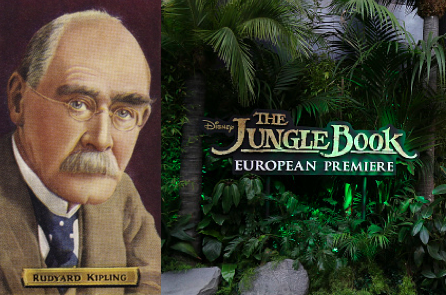The famed but controversial author of the Jungle Book, Rudyard Kipling, visited Singapore in late March 1889. He spent his time exploring the city, dining at Raffles Hotel and visiting the Botanic Gardens.
Here are his observations of Singapore in 1889, recorded in his book, From Sea To Sea And Other Sketches, Letters of Travel.
Singapore's population
There were many Chinese and Europeans in Singapore, as Kipling observed:
They are all Chinese, except where they are French or Dutch or German. England is by the uninformed supposed to own the island. The rest belongs to China and the Continent, but chiefly China.
It is likely that Kipling was exaggerating the ethnic composition of the population. It also suggests that Kipling did not venture beyond the Chinatown, Raffles Place and Beach Road area.
Nevertheless, even in the likes of the Chinatown, there were Malays and Indians, which Kipling failed to pick out.
[caption id="" align="aligncenter" width="699"] Street scene at the junction of South Bridge Road and Cross Street in Chinatown. Source: NAS[/caption]
Street scene at the junction of South Bridge Road and Cross Street in Chinatown. Source: NAS[/caption]
Singapore's Chinese population
On the Chinese population in Singapore, Kipling noted that there were ongoing problems between the group's secret societies and colonial authorities, which resulted in some form of unrest that saw the colonial government taking action to exert control.
Singapur had just passed a Bill (Ordinance they call it) putting down all Chinese secret societies in the colony, which measure only awaited the Imperial assent. A little business in Singapur connected with some municipal measure for clearing away overhanging verandas created a storm, and for three days those who were in the place say the town was entirely at the mercy of the Chinese, who rose all together and made life unpleasant for the authorities. This incident forced the Government to take serious notice of the secret societies who could so control the actions of men, and the result has been a measure which it will not be easy to enforce.
[caption id="" align="aligncenter" width="632"] Source: NAS[/caption]
Source: NAS[/caption]
Demonstrating some deft understanding of this issue, Kipling noted the vital role that the secret societies played to the Chinese population back then.
A Chinaman must have a secret society of some kind. He has been bred up in a country where they were necessary to his comfort, his protection, and the maintenance of his scale of wages from time immemorial, and he will carry them with him as he will carry his opium and his coffin.
Singapore's European population
Kipling was critical of some of the Europeans' everyday practices in Singapore.
He came across two large Dutch ladies who were wearing night-gowns in the middle of the day, and were seated with their feet propped on a chair. His disapproval of their dressing was clear:
A lady in a dressing-gown disturbs the mind and prevents careful consideration of the political outlook in Singapur, which is now supplied with a set of very complete forts, and is hopefully awaiting some nine-inch breech-loaders that are to adorn them.
[caption id="" align="aligncenter" width="338"] A night-gown from the late 1800s. Source[/caption]
A night-gown from the late 1800s. Source[/caption]
On the Englishmen who were probably administrators for the colonial government, Kipling had reservations on their professional priorities.
The men are not really lazy, as I will try to show later on, but they lounge and loaf and seem to go to office at eleven, which must be bad for work. And they all talk about going home at indecently short intervals, as though that were their right.
In likely reference to the health situation among the Europeans in Singapore, Kipling observed:
People in Singapur are dead-white - as white as Naaman — and the veins on the backs of their hands are painted in indigo.
It is as though the Rains were just over, and none of the womenfolk had been allowed to go to the hills. Yet no one talks about the unhealthiness of Singapur. A man lives well and happily until he begins to feel unwell. Then he feels worse because the climate allows him no chance of pulling himself together — and then he dies. Typhoid fever appears to be one gate of death, as it is in India; also liver.
Early plans for the Causeway and railway linking Singapore to Malaya
In 1889, there was no Causeway or railway linking Singapore to Malaya. The Causeway would only be built 34 years later in 1923.
Nonetheless, Kipling noted from reading the local newspapers that there were intentions to construct them.
So far the Straits papers spend their space in talking about them, for at present there are only twenty-three or twenty-four miles of narrow-gauge railway open, near a civilised place called Pirates' Creek, in the Peninsula. The Sultan of Johore is, or has been, wavering over a concession for a railway through his country, which will ultimately connect with this Pirates' Creek line. Singapur is resolved ere long to bridge over the mile or mile-and-a-half Straits between herself and the State of Johore.
Having ties to Singapore via his in-laws
Interestingly in 1891, two years after Kipling's visit to Singapore, he married Carrie Balestier, whose grand uncle (her father's brother), Joseph Balestier, had served as the United States' first consul to Singapore from 1837 to 1852.
The Balestier name lives on in Singapore's Balestier Road.
Top image from Getty Images.
Related Article:
Jungle Book author Rudyard Kipling ate ‘turtle steaks’ in S’pore’s Raffles Hotel in 1889
If you like what you read, follow us on Facebook and Twitter to get the latest updates.
If you like what you read, follow us on Facebook, Instagram, Twitter and Telegram to get the latest updates.
